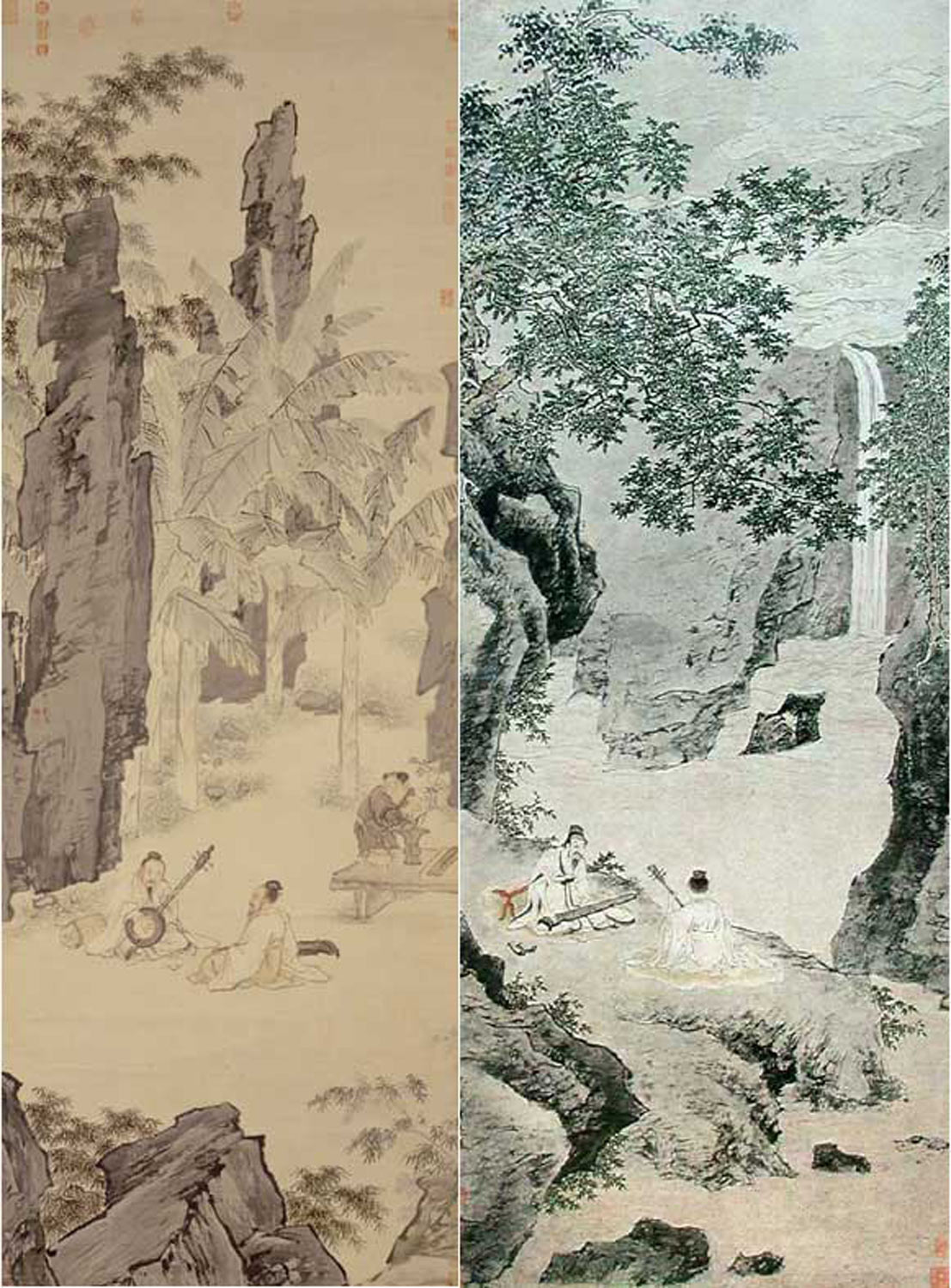|
T of C
Home |
My Work |
Hand- books |
Qin as Object |
Qin in Art |
Poetry / Song |
Hear, Watch |
Play Qin |
Analysis | History |
Ideo- logy |
Miscel- lanea |
More Info |
Personal | email me search me |
| Artists with the Guqin | 首頁 |
| Qiu Ying | 仇英 1 |
|
See Wikipedia, etc.
|
Left: 蕉陰結夏 In the shade of banana trees whiling away summer
2
Right: 停琴聽阮 Stopping the qin to hear a ruan 3 |
 Qiu Ying, 1494 - 1552, executed quite a number of paintings with qin players. A net search will find some of them, but mostly only those that have "qin" in the title. Thus they generally would not find ones such as the left one in the pair at right, called In the shade of banana trees whiling away summer. The examples at right form a particularly interesting pair. Both feature a qin zither and and ruan lute.4
Qiu Ying, 1494 - 1552, executed quite a number of paintings with qin players. A net search will find some of them, but mostly only those that have "qin" in the title. Thus they generally would not find ones such as the left one in the pair at right, called In the shade of banana trees whiling away summer. The examples at right form a particularly interesting pair. Both feature a qin zither and and ruan lute.4
Quite a few Qiu Ying paintings are used here on this website to illustrate qin melodies.5 However, Qiu Ying himself is said not to have come from a literati family, and I have yet to find evidence that he played himself qin.
Footnotes (Shorthand references are explained on a separate page)
1.
Qiu Ying 仇英
See further in Wiki, etc.
(Return)
2.
In the shade of banana trees whiling away summer 蕉陰結夏
In the collection of the
National Palace Museum, Taiwan.
(Return)
3.
Image: Stopping the qin to hear a ruan 停琴聽阮
In the collection of the
Guangzhou Museum (?). A net search for the Chinese title yields numerous more recent paintings with this title (but 845.xxx).
(Return)
4.
Image: 琴阮 Qin zither and ruan lute
Ruan (Wiki; a plucked
lute) and qin were the two instruments associated with the
Seven Sages of the Bamboo Grove. This inspired quite a few artists to depict qin and ruan together. There also was once at least one
Manual for qin and ruan.
In addition to the two Qiu Ying paintings here, other examples in art of this pairing include:
- Court Ladies in the Style of Zhou Wenju (仿周文矩宮中圖 anonymous, 12th c.)
- Listening to a Ruan (聽阮圖 Ting Ruan Tu), by 劉彥衝 Liu Yanchong (刘彦冲 1807—1847; original is in the Beijing National Palace Museum).
- Palace Women Playing Qin and Ruan (內人琴阮圖 Neiren Qin Ruan Tu; no image), by 趙千里 Zhao Qianli (1127 - 1162)
On this painting 楊維楨 Yang Weizhen (1296-1370) inscribed a poem for his contemporary, the scholar 顧英 Gu Ying. It is not clear whether the painting itself has survived, but the poem has, as follows:內人琴阮圖 - 詩詞正文 元 楊維楨 花點吳鹽春欲老,翡翠飛來剪芳草。
美人睡起春思深,彈絲拊木寫同心。
荔枝五弦調急緩,阮家月琴軸初綰。
須臾鈞天雙合樂,南薰殿中風動幕。
梨園樂官樂不鳴,宮中之音和且平。The second couplet refers to qin and ruan in the context of spring yearnings (Chun Si):
The beauties rise from sleep, full of spring yearnings:
Plucking strings, sweeping plectrum, depicting shared hearts.Thanks to Jonathan Chaves for pointing this out and providing the translation.
Less directly connected but also interesting is the calligraphy "Xi (Kang) plays Qin while Ruan (Ji) Whistles" (嵇琴阮嘯 Xi Qin Ruan Xiao). This phrase suggests refined amusement, as with the Seven Sages. Its earliest appearance seems to be as the second half of 布射僚丸,嵇琴阮嘯, the 115th couplet of the famous 125 couplet Thousand Character Classic (Wiki; see the complete online translation by Nathan Sturman). A famous early example of this in art is in the Thin Stroke Calligraphy of the Thousand Character Essay (瘦金千字文 Shoujin Qianziwen) attributed to Song Huizong, a complete version of which is online. Online one can also find a number of examples of calligraphy just for the four-character phrase by itself.
Further afield is
this illustration of a qin and lute playing together. Adapted by Bai Yunli from this Qiu Ying painting, it was inspired by a possible
Matteo Ricci program.
(Return)
5.
Qiu Ying paintings used to illustrate qin melodies
Searching this site for "Qiu Ying" turns up such examples as,
There are quite likely more.
(Return)
Return to Art Illustrating Guqin Melodies